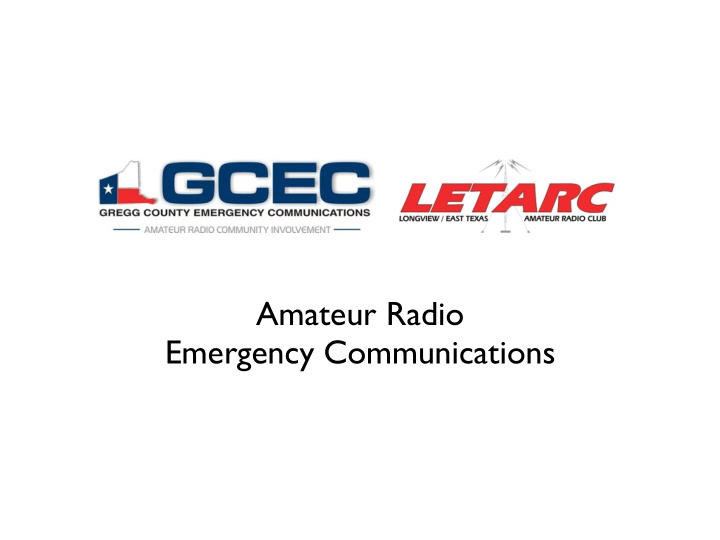



Amateur Radio Emergency Communications
Where Does Amateur Radio Fit in Emergency Communications?
Potential Gregg County Threats • Communications Emergency ★ Outage or Overload of Public Service Communications • Weather-Related ★ Tornadoes, Hail, Flash Floods ★ Hurricane-spawned tornadoes, flash floods ★ Hurricane coastal or interstate evacuations • Hazard Material Events ★ Railcar or trailer incident ★ Chemical or power plant incident • Medical-Related Events ★ Epidemic • Terrorism ★ IED incident ★ WMD incident
Amateur Radio Primary Mission and Roles • Primary Mission Provide an alternate or supplemental communications infrastructure and message traffic handling capability utilizing local amateur radio resources, to serve government or private served agencies when requested. • Primary Roles ★ Skywarn weather spotting/reporting for NWS ★ Supplementary and/or Backup Incident Communications ✴ Available in case main incident comms fail/overloaded ✴ Shadowing Key Incident Officer personnel ★ Assigned to provide communications infrastructure and/or operations for another volunteer group ✴ Red Cross, CERT, Salvation Army, etc.
Emergency Communications in Amateur Radio • Amateur Radio Emergency Service (ARES) • Part of ARRL Field Organization • Not restricted by FCC Part 97 in terms of drills • ARRL is an NVOAD and affiliated with Citizen Corps • Radio Amateur Civil Emergency Service (RACES) • Dates back to 1950’s as part of the Civil Defense • Specifically defined/restricted by FCC Part 97 • Overseen by FEMA • Military Auxiliary Radio System (MARS) • Overseen by Department of Defense (Tri-Service) • Uses amateur equipment, but outside amateur bands • Increasingly being used by State of Texas EM • Overseen/sponsored by National Weather Service • Usually part of local Amateur Radio EMCOMM group • Spotters report observations to supplement Radar • Provide data during weather-related disasters
ARES/RACES & American Radio Relay League • Interacts with government AND “served” agencies • Activated by ARES Emergency Coordinator (EC) • Network of Local-based organizations • Drills/Nets not restricted by FCC Part 97 • ARES stations can communicate with any Amateur • Follows NIMS procedures • Interacts with State or Local governments • Activated by request of State or Local governments • Can be a State-Level or Local organization • Drills/Nets restricted by FCC Part 97 • RACES stations limited to RACES-authorized stations • Follows NIMS procedures • ARRL recommends groups have dual affiliation • Usually same people used for both in most locales • ARES can allow drills/nets when RACES cannot • Complimentary, but mostly common practices
ARES Operational Model Old Local MOU Model New EM Model • Local Memo of Understanding • Designed to support ICS/NIMS with individual served agencies model • Did not always recognize single • Recognizes single command resource/command management management of EM volunteer • Reduces flexibility in larger, more resources • Allows maximum flexibility for complex incidents if tied to one served agency potential assignment • Potential priority and • Reduces potential priority and coordination conflicts for coordination conflicts for Amateur Radio infrastructure Amateur Radio infrastructure resources resources • Being de-emphasized by ARRL • Model being used by Gregg • Not used in Gregg County ARES County ARES
How Local Organizations Fit Into NIMS and a Declared Emergency/Disaster Assistance Joint Field Office Federal Agencies and Departments Technical Resources & Funding Specialists Equipment HF Liaison Nets National Incident Intrastate Mutual Aid/ Management System (NIMS) Interstate Mutual Aid/ and State EOC (EMAC) Private Sector/ National Response NGO Assistance Framework (NRF) Local-to-Local Mutual Aid/ Local EOC Private Sector/ NGO Assistance Coordination Command Area Command/ NGO Incident Typical Focus Areas: Unified Area Command CERT: Preparedness, Search/Rescue, Medical Incident Command/Unified Command Red Cross: Damage Assessment, Shelter, Medical, Financial Aid GCEC: Skywarn & Incident Supplemental/Backup Communications Requests
Incident Command System Structure and Typical Amateur Radio Placement
ARRL ARES Organization Structures in North Texas and Gregg County
ARRL North Texas Section ARES Districts Additional Section/National ARRL ARES Resources Available if Local Resources Not Sufficient for a Specific EmComm Incident
Current Local/State ARES & RACES Structures ARRL HQ Field Organization/Emergency Preparedness Steve Ewald - WV1X / Mike Corey - W5MPC ARRL North Texas ARES Section EC (SEC) Walt Mayfield - KE5SOO ARRL NTX District 8 ARES District EC (DEC) Gary Lewis - WG5L Gregg County ARES Emergency Coordinator (EC) Gary Lewis - WG5L AEC AEC AEC AEC Darrell Toland Kurt Harris Tom Noe Jim Quinn N5REO KD5UVB W5TDN AJ1MQ Region 1 RACES Officer (RRO) - John Newman - N9JN District 12 RACES Officer (DRO) - Phil Clements - K5PC Gregg County RACES Officer (CLO) - Darrell Toland - N5REO CLO ALT CLO ALT CLO ALT Gary Lewis - WG5L Tom Noe - W5TDN Kurt Harris-KD5UVB
Current Local Skywarn Structure Primary Mobile Spotters Kurt Harris - KD5UVB Radar Observer Larry Morgan - KE5KEI Gary Lewis - WG5L Jim Quinn - AJ1MQ Priscilla Quinn - AA5PQ NWS and City of Longview Net Control Reports Tom Noe - W5TDN Darrell Toland - N5REO Stationary “At Home” Spotters - Various
Key Online Resource: LETARC Web Site http://www.letarc.org (Emergency Communications Menu Item)
ARES Page and EmComm Compendium http://www.letarc.org/main/emergency-communications-3/are/
GCEC/LETARC EmComm Compendium • Executive Overview • This Overview Presentation • Served Agency Contact List • Local ARES Unit Participants Guide FEMA & ARRL training and operating capability ★ requirements • Gregg County Amateur Radio Emergency Communications Plan Infrastructure inventory, frequency plan, and possible ★ deployment scenarios • Skywarn Net Operations Specific Skywarn net operations procedures ★ • ARES Net Operations Specific ARES net operations procedures ★
Skywarn Page http://www.letarc.org/main/emergency-communications-3/skywarn/
ARES Participant Registration/Data Collection http://www.letarc.org/main/emergency-communications-3/emcomm-registration/ Must Be Registered for LETARC Site & Logged In To See Form Select Data Items Shown - Additional Items on Multi-Page Form
Recommend
More recommend